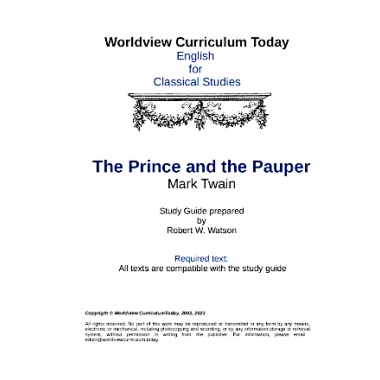The Prince and the Pauper
Number of lessons: 14; compatible text for study guide: all texts are compatible (you may order the text below). Guide prepared by Robert W. Watson.
$0.00
Order text here
Note: This guide is included in the course, An Introduction to Literature.
Almost every commentator suggests that Mark Twain wrote The Prince and the Pauper as a children’s book in order to gain a younger audience. However, it is dif icult to believe that Twain would write a historical novel merely to entertain young people. Like most authors, Twain wrote with purpose. On the surface, the story appears to be a delightful tale about two boys switching roles by accident. But much deeper are the philosophical and social beliefs which Twain was challenging.
Through The Prince and the Pauper, Twain is clearly attacking two social institutions: one political and the other legal. Twain ridicules the political doctrine of the “divine right of kings”; yet, he is able to do so in an inoffensive manner. While many today laugh at this doctrine, even in Twain’s day, this political idea was no longer taken seriously by most nations.
However, the use of capital punishment for petty crimes was very much in place, not only in England, but in the United States as well. Also, the conditions of prisons as described in the story was not far removed from the prisons in nineteenth‐century America. As you read this tale, notice how Twain succeeds by making the legal system to appear grossly unjust by anyone’s standards.
Note: This guide is included in the course, An Introduction to Literature.
Almost every commentator suggests that Mark Twain wrote The Prince and the Pauper as a children’s book in order to gain a younger audience. However, it is dif icult to believe that Twain would write a historical novel merely to entertain young people. Like most authors, Twain wrote with purpose. On the surface, the story appears to be a delightful tale about two boys switching roles by accident. But much deeper are the philosophical and social beliefs which Twain was challenging.
Through The Prince and the Pauper, Twain is clearly attacking two social institutions: one political and the other legal. Twain ridicules the political doctrine of the “divine right of kings”; yet, he is able to do so in an inoffensive manner. While many today laugh at this doctrine, even in Twain’s day, this political idea was no longer taken seriously by most nations.
However, the use of capital punishment for petty crimes was very much in place, not only in England, but in the United States as well. Also, the conditions of prisons as described in the story was not far removed from the prisons in nineteenth‐century America. As you read this tale, notice how Twain succeeds by making the legal system to appear grossly unjust by anyone’s standards.

